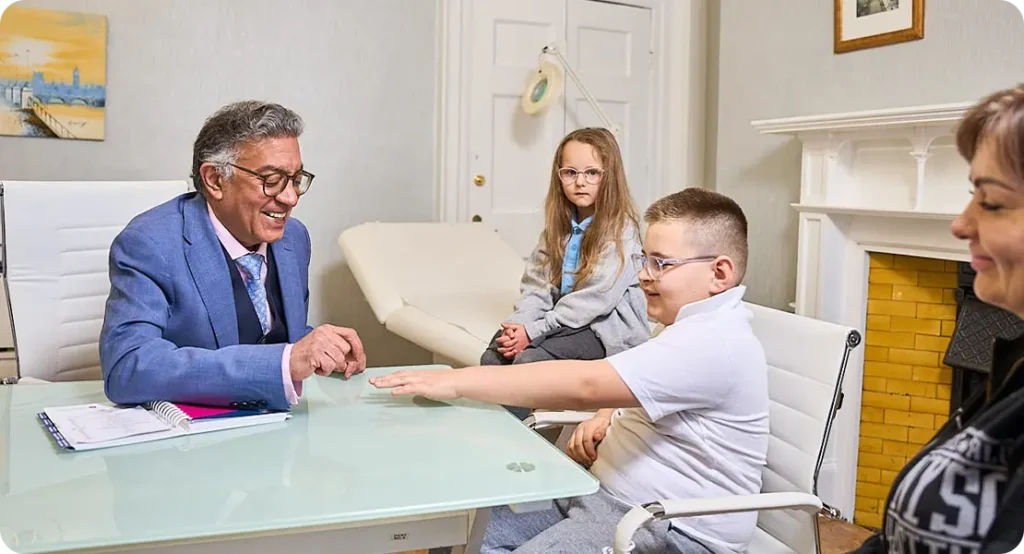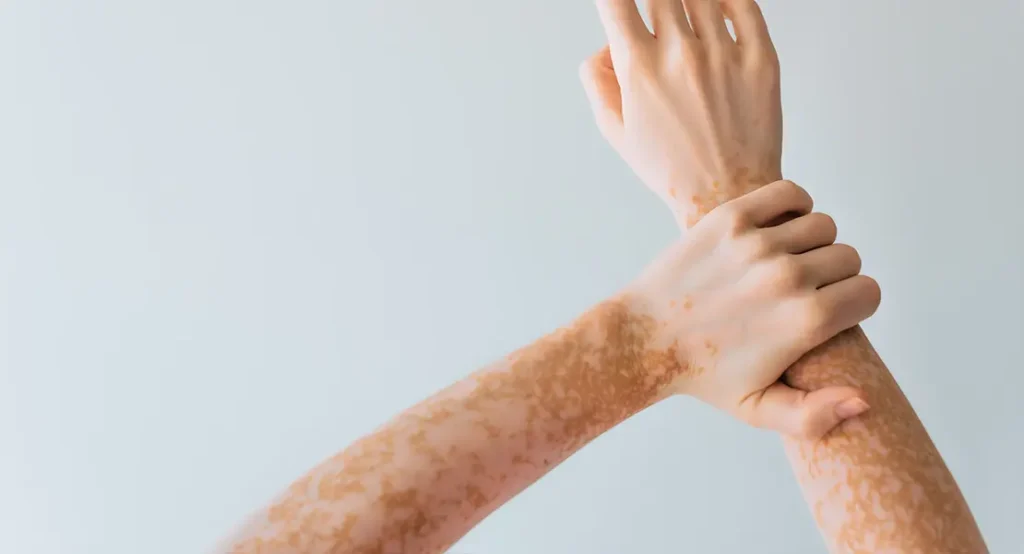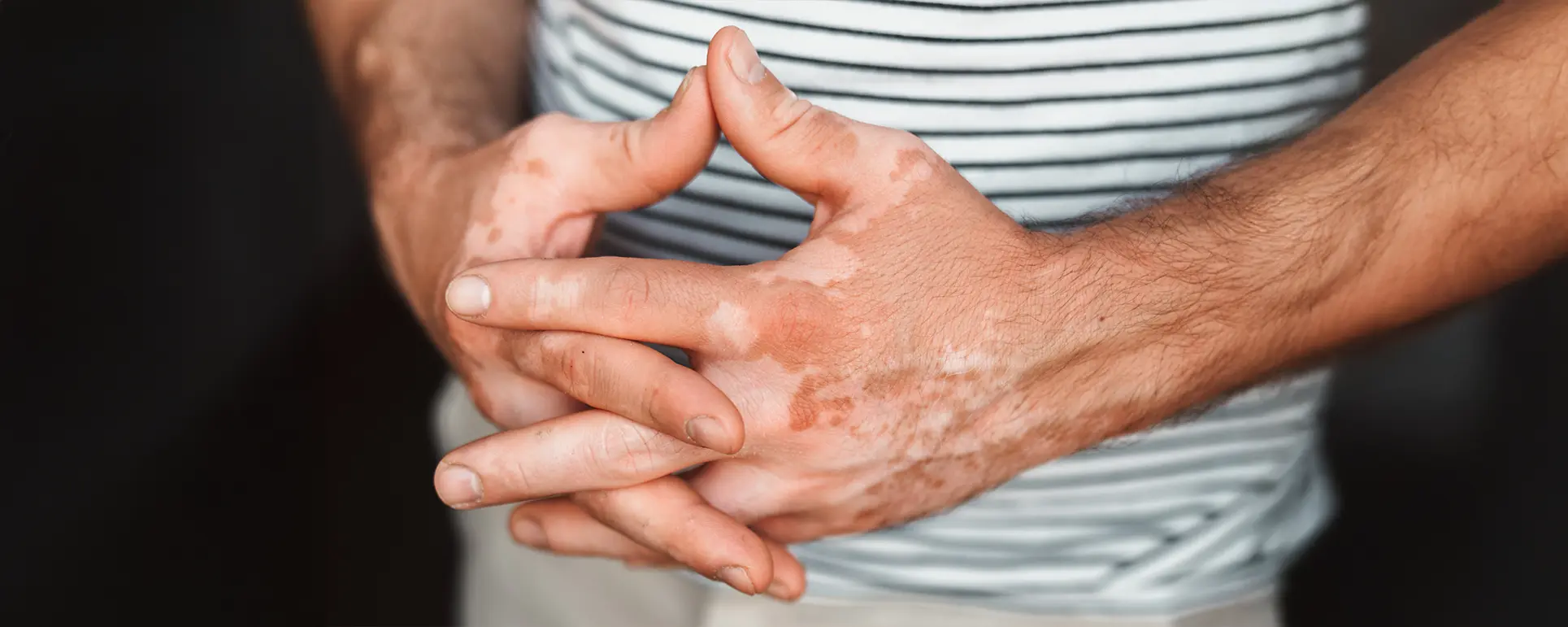Vitiligo can appear at any stage of life, but how it shows up and how it behaves often depends on the age of onset. In children, one of the most commonly observed forms is segmental vitiligo, which typically affects only one part or side of the body. This type tends to appear suddenly and spread quickly at first, but then stabilises, often without further progression. It’s less likely to be associated with autoimmune conditions, making it somewhat distinct in its behaviour.
On the other hand, adults are more frequently diagnosed with non-segmental vitiligo, the more common and chronic form. This version usually shows up in a symmetrical pattern, affecting both sides of the body like the hands, face, or feet and tends to progress gradually over time. It’s also more often linked with other autoimmune diseases such as thyroid disorders or diabetes, adding complexity to its management.
These differences don’t just impact diagnosis they also influence treatment strategies and expectations for repigmentation. For example, segmental vitiligo in children may respond better to early interventions like topical therapies or phototherapy, whereas non-segmental vitiligo in adults might require long-term, multi-pronged treatment approaches. Understanding these age-related distinctions helps doctors personalise care and guide patients and families more effectively through their treatment journey.
Psychological and emotional impacts also vary between children and adults with vitiligo. For children, visible skin changes can lead to self-consciousness at school or social gatherings, sometimes affecting their self-esteem early on. Adults, meanwhile, may struggle with confidence in professional or personal settings, especially if the condition progresses rapidly. In both cases, emotional support and counselling can be just as important as medical treatment. Addressing the mental and social aspects of vitiligo is crucial for overall well-being, regardless of age.
Onset and Initial Presentation
Vitiligo can occur at any stage of life, but its initial signs often differ depending on age. In children, segmental vitiligo is more common, usually affecting just one side or specific part of the body. It tends to appear suddenly and then remain stable over time, unlike other forms that keep spreading. Early onset in children can sometimes go unnoticed if it’s mistaken for a minor skin issue.
In adults, non-segmental vitiligo is more frequently seen and typically presents in a symmetrical pattern affecting both sides of the body equally. This form is progressive and may slowly expand across different areas, often linked with other autoimmune conditions. Adults might also experience emotional stress or health triggers that accelerate the condition. Its gradual nature makes consistent monitoring essential for effective management.
Diagnosing vitiligo especially in children can be challenging, as it can resemble conditions like pityriasis alba or tinea versicolor. That’s why dermatologists rely on a mix of clinical exams, family history, and tools like a Wood’s lamp to confirm the diagnosis. Early identification is key to preventing unnecessary treatments and setting the right care plan. A correct diagnosis also helps reduce anxiety for both the child and their family.
Rate of Progression and Stability
Vitiligo progression varies greatly from person to person, but the age of onset can play a major role in how quickly the condition develops. In children, segmental vitiligo often stabilises after a quick initial spread, offering a more predictable course. On the other hand, non-segmental vitiligo in adults typically progresses gradually, sometimes over many years. This slow spread can be linked to long-term exposure to environmental triggers, lifestyle factors, and changes in immune system regulation.
Even though segmental vitiligo in children is usually more stable, its appearance especially on the face can cause significant emotional and cosmetic concern. For adults, the steady expansion of depigmented areas can result in larger, more visible patches that impact self-esteem and quality of life. These patterns highlight the importance of setting age-appropriate treatment goals and expectations. Tailoring treatment plans to the patient’s life stage can make them more effective and easier to follow.
Some studies suggest that the immune system in children may respond more flexibly to early treatment, offering a better chance at stabilisation. This has sparked interest in age-specific immunomodulatory therapies aimed at targeting the disease in its early stages. Recognising and responding to early signs quickly is key to improving long-term outcomes. Regular follow-ups help in tracking changes and adjusting the treatment approach as needed.
Genetic and Environmental Influences
Genetic predisposition plays a central role in both paediatric and adult vitiligo, though it may be more influential in cases that begin at a younger age. Children with a family history of autoimmune disorders are statistically at a higher risk, suggesting a stronger genetic component. This connection can help clinicians anticipate and screen for vitiligo in susceptible individuals. Understanding family history early on can support quicker diagnosis and more focused care.
In adults, environmental triggers like stress, skin trauma, or exposure to certain chemicals often work hand-in-hand with genetics to spark or worsen vitiligo. At the cellular level, epigenetic changes such as DNA methylation and histone modification may also shape when and how the condition appears. These changes can influence how genes involved in pigmentation and immune regulation behave. Scientists believe these age-specific molecular differences could explain why vitiligo develops differently across the lifespan.
Environmental and lifestyle exposures also vary by age, influencing disease risk and progression. Children may react to ingredients in soaps, lotions, or foods, while adults might be affected by workplace chemicals or chronic psychological stress. These differing exposures call for a more personalised approach to lifestyle and environmental management. By identifying and avoiding specific triggers, treatment outcomes may improve for both children and adults.
Treatment Modalities and Age-Specific Considerations

Children and adults typically require different treatment strategies, mainly due to differences in skin sensitivity, immune system development, and how their bodies respond to medication. While topical corticosteroids and calcineurin inhibitors are standard first-line treatments for both age groups, children are usually prescribed lower-potency versions to minimise the risk of thinning skin or irritation. Because younger skin is still developing, extra care must be taken to avoid long-term damage. Frequent follow-ups are essential to monitor both progress and side effects.
Adults generally have access to a broader range of treatment options, especially in more advanced or widespread cases. Therapies like oral corticosteroids or JAK inhibitors are more commonly used in adults, as their bodies can better handle potential side effects under proper medical supervision. However, these treatments still require regular monitoring to manage risks such as immune suppression or metabolic issues. For adults, the decision to pursue systemic treatment often comes down to balancing symptom severity with overall health status.
In paediatric care, the long-term safety of any treatment is always a top priority. Doctors aim to strike a balance between effective disease control and minimal side effects, especially during critical growth years. As a result, many new treatments now in clinical trials are being carefully evaluated with age-specific safety data.
Response to Therapy and Prognosis
Children with vitiligo often respond more quickly and effectively to early treatment compared to adults. This may be because the disease is caught sooner and their skin has a stronger regenerative ability. Younger patients also tend to have more flexible immune systems, which may contribute to better healing. In cases of segmental vitiligo, even though it’s typically harder to treat, early and focused therapies can still make a meaningful difference.
For adults, managing vitiligo can be more challenging, especially if the condition has been present for many years. The longer duration and wider spread of depigmentation often mean that topical creams or phototherapy alone aren’t enough. That’s why combination treatments including systemic options are often considered for more complex cases. Age-related changes in immune activity and skin response can also impact how well a treatment works.
Overall, prognosis tends to be more positive in children when the condition is diagnosed early and addressed promptly. Ongoing care, including maintenance therapy and regular check-ups, plays a crucial role in preventing flare-ups or relapse in both children and adults. The success of treatment often depends not just on the therapy itself, but also on consistent follow-through and emotional support. Encouraging patients and families to stay engaged in the treatment journey makes a lasting impact.
Psychological Impact Across Age Groups
The psychological burden of vitiligo is significant, though it often shows up differently in children and adults. For children especially teenagers teasing or bullying at school can lead to feelings of anxiety, low self-worth, and even social isolation. Addressing these issues early through psychological support is crucial to prevent lasting emotional effects.
Here’s how the emotional impact varies by age:
- Children may face teasing or bullying, resulting in anxiety, low self-esteem, or social withdrawal.
- Teenagers often struggle with body image, especially during key social and emotional development years.
- Adults may feel embarrassed or stigmatised, which can affect personal relationships and job performance.
Supporting mental wellbeing is essential:
Both children and adults can benefit from therapy, counselling, or support groups to navigate these challenges. By recognising the emotional toll vitiligo can take, dermatologists and caregivers can make mental health support a core part of treatment. A multidisciplinary care model, blending psychological and medical interventions, ensures more holistic and effective care for people living with vitiligo.
Family Dynamics and Support Structures
Family support is incredibly important when managing vitiligo, particularly for children who depend on adults for daily care. Parents or guardians are often responsible for applying treatments, ensuring follow-up visits, and providing emotional comfort during flare-ups. Their involvement can make a significant difference in how a child copes with the condition. When families are well-informed and emotionally supportive, children tend to feel more confident and less isolated.
Here’s how support plays a role at different stages of life:
- Children benefit from active family involvement, including help with treatment routines and emotional reassurance.
- Adults often rely on partners and friends, and the strength of these relationships affects their mental wellbeing.
- Awareness and open dialogue within families or social circles reduce feelings of shame or isolation.
There’s evidence that adapting support systems to suit a person’s stage of life leads to better emotional outcomes. While younger patients thrive with family-based care, adults may prefer individual counselling or support groups. Whether it’s strong family bonds or peer understanding, having the right people involved makes the journey with vitiligo more manageable.
Coexisting Autoimmune Conditions
Vitiligo is frequently linked to other autoimmune disorders in both children and adults, though the specific comorbidities often vary by age. In children, thyroid dysfunctions like Hashimoto’s thyroiditis are more commonly observed, sometimes even before vitiligo symptoms appear. Adults, on the other hand, are more likely to experience related conditions such as alopecia areata, type 1 diabetes, or rheumatoid arthritis. These overlapping conditions highlight the need for a broader medical perspective during diagnosis.
Routine screening is essential in both groups to catch coexisting conditions early and manage them proactively. Blood tests for thyroid antibodies, blood glucose levels, and other autoimmune markers help uncover hidden health issues that may otherwise go unnoticed. Regular monitoring allows doctors to adjust treatment plans based on the patient’s full health profile. Early detection not only helps prevent complications but also enhances the overall effectiveness of vitiligo therapy.
When multiple autoimmune conditions are present, treatment can become more complex especially if immunosuppressive medications are required. Some therapies may help one condition while worsening another, making it vital to find a balanced approach.
Educational and Social Integration
For children with vitiligo, navigating school life can come with emotional and social hurdles from handling curious stares to coping with occasional teasing or exclusion. Creating awareness among teachers and classmates can foster a more understanding and inclusive atmosphere. When schools are proactive in educating students about vitiligo, children feel safer and more accepted. This support plays a key role in reducing anxiety and building confidence during formative years.
Adults face a different set of challenges when it comes to social or professional environments. In workplaces or public settings, a lack of awareness about vitiligo can sometimes lead to misunderstanding, uncomfortable questions, or even subtle forms of bias. These experiences can affect a person’s confidence and willingness to engage socially. Promoting education through awareness campaigns and inclusive policies helps reduce stigma and improve day-to-day interactions.
In both age groups, societal understanding can have a powerful impact on mental health and self-worth. Whether it’s a child in the classroom or an adult in the boardroom, inclusive behaviour and acceptance go a long way. Encouraging fairness, empathy, and open conversations ensures that people with vitiligo are not just seen but truly supported.
Future Directions in Age-Specific Research
Ongoing research is helping us better understand how vitiligo progresses differently in children and adults. Age-stratified clinical trials are now exploring how specific treatments perform across these groups, highlighting differences in response and safety. These targeted studies are essential for shaping treatment guidelines that are not only effective but also safe for each age group. As data grows, clinicians will be able to make more confident, individualised decisions.
Another exciting area is the search for biomarkers molecular indicators that could predict how someone might respond to treatment based on their age. These efforts could help identify which therapies will work best for a child versus an adult before treatment even begins. Understanding these biological differences at the cellular level brings us one step closer to true personalised medicine. It’s a shift from one-size-fits-all care to precision-based approaches tailored to each patient’s needs.
To make these innovations meaningful in real-world care, collaboration between paediatric and adult dermatologists is essential. Sharing findings, patient outcomes, and clinical experiences can bridge knowledge gaps and ensure that insights benefit patients at every stage of life. This kind of teamwork will not only refine treatment plans but also enhance the long-term quality of care for people living with vitiligo.
Hormonal Influence and Gender Considerations

Hormonal fluctuations can play a significant role in the manifestation and severity of vitiligo. Children entering puberty may see changes in their vitiligo due to hormonal shifts, particularly involving adrenal and thyroid hormones. These fluctuations may either stabilise or exacerbate depigmentation.
In adults, hormonal changes related to pregnancy, menopause, or chronic stress may similarly impact the disease course. Women, in particular, may experience flare-ups during periods of hormonal imbalance. Understanding these trends is key to managing vitiligo in female patients across age groups.
Targeted hormone assessments may help predict flare-ups or relapses. Integrating endocrinological insights into dermatological care could improve personalised treatment strategies. Further research is needed to fully explore these hormonal connections.
Final Thoughts: Embracing Age-Specific Care in Vitiligo Management
Vitiligo affects individuals differently at every stage of life, demanding personalised treatment and support. From immune system differences to psychological impacts and treatment responsiveness, age is a defining factor in how the condition should be managed. By embracing these distinctions, healthcare professionals can improve both outcomes and quality of life.
Ongoing research continues to inform best practices, ensuring that new therapies and strategies are evaluated with age-specific needs in mind. Whether it’s addressing oxidative stress in adults or ensuring emotional support for children, a comprehensive approach is essential. Contact our vitiligo clinic in London to schedule a consultation with one of our expert dermatologists and receive a personalised treatment plan tailored to your age and individual needs.
References:
- Ezzedine, K., Eleftheriadou, V., Whitton, M. and van Geel, N., 2015. Vitiligo. The Lancet, 386(9988), pp.74–84. Available at: https://www.thelancet.com/journals/lancet/article/PIIS0140-6736(14)60763-7/fulltext [Accessed 2 June 2025].
- Picardo, M., Dell’Anna, M.L., Ezzedine, K., Hamzavi, I., Harris, J.E. and Parsad, D., 2015. Vitiligo clinical practice guidelines of the European Dermatology Forum. Journal of the European Academy of Dermatology and Venereology, 29(5), pp.729–742. Available at: https://onlinelibrary.wiley.com/doi/10.1111/jdv.13161 [Accessed 2 June 2025].
- Taïeb, A. and Picardo, M., 2009. Clinical practice. Vitiligo. New England Journal of Medicine, 360(2), pp.160–169. Available at: https://www.nejm.org/doi/full/10.1056/NEJMcp0804388 [Accessed 2 June 2025].
- Bergqvist, C., Ezzedine, K., 2021. Vitiligo: A focus on pathogenesis and its therapeutic implications. Journal of Dermatological Science, 104(1), pp.2–10.
- Rodrigues, M., Pandya, A.G., Silverberg, N., Brezzani, L. and Harris, J.E., 2017. Current and emerging treatments for vitiligo. Journal of the American Academy of Dermatology, 77(1), pp.17–29. doi:10.1016/j.jaad.2016.12.019.
